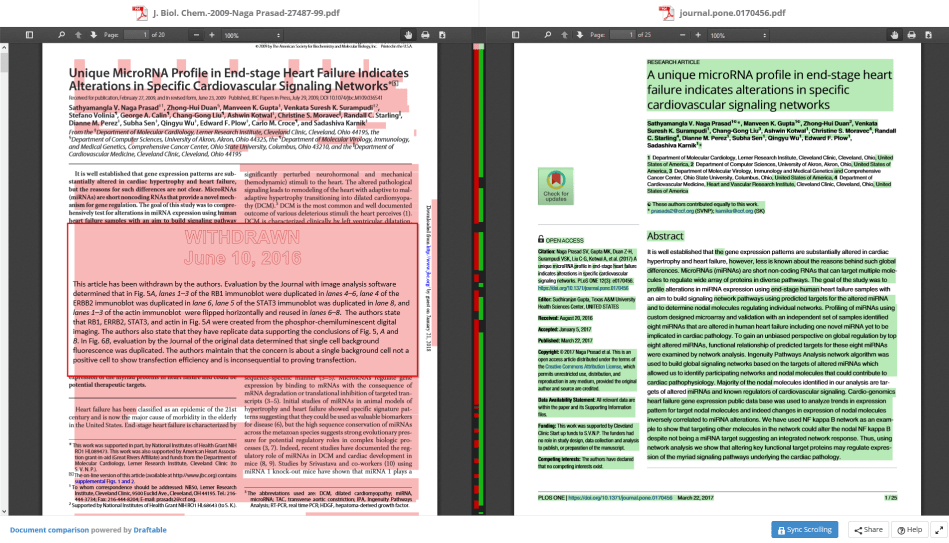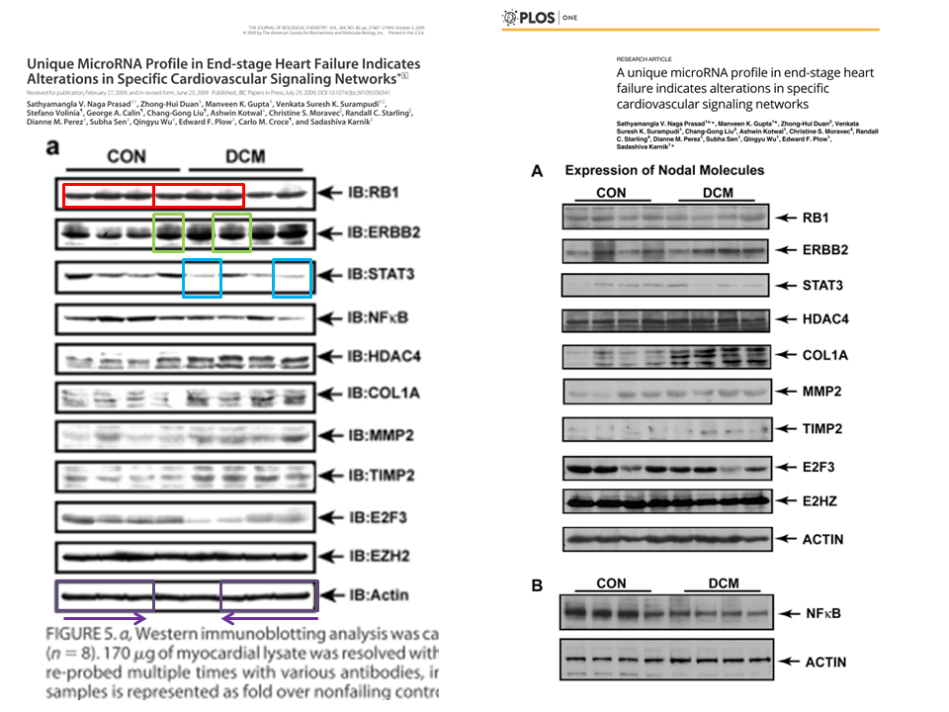On July 29th 2016, Journal of Biological Chemistry (JBC) retracted a cardiology paper from 2009 for data manipulations. Only some days later, on August 20th 2016, the corresponding authors Sathyamangla Naga Prasad and Sadashiva Karnik (both from the same Department of Molecular Cardiology at Cleveland Clinic in Ohio, US, submit that same paper, under same title, with only some changes, to PLOS One. All authors remained the same, only two mysteriously fell off the paper: George Calin and his former mentor Carlo Croce. The latter is a notorious cancer researcher from Ohio State University, PubPeer star accused of misconduct and author on 7 retracted papers (according to the new Retraction Watch database). Croce even made it into New York Times, which he now sues, together with his critic David Sanders. (some more details here).
It makes sense why Prasad and Karlin decided to play it safe and throw their toxic Ohio colleague Croce and his loyal former lab member Calin off their paper. They even replaced a fake western blot which caused the JBC retraction. This refurbished PLOS One paper was accepted on January 5th 2017 and published on March 22nd 2017. Now also the handling editor at PLOS has now a lot of explaining to do: Sudhiranjan Gupta, from Texas A&M University. A man who understood Prasad’s and Karnik’s dilemma, because also Gupta has his own record of gel band duplications on PubPeer, all of these incidentally with his former boss at Cleveland Clinic, Subha Sen, who in turn is co-author on both the retracted Prasad et al JBC 2009 and the new Prasad et al PLOS One 2017.
Using the free online plagiarism tool at Draftable.com, I was able to establish an extensive textual overlap, the files are available here and here. The well-known sleuth Claire Francis established figure re-use, which I document below.

The questions this incident raises are:
- Does PLOS really perform plagiarism screens on all manuscripts they accept?
- Does PLOS mind previous retractions which happened due to data manipulation?
- Does PLOS think a retracted paper never existed, so the authors can re-publish it again, in good faith?
- Does PLOS have any integrity and conflict of interest guidelines for its editors?
![hCuaYKT[1]](https://forbetterscience.com/wp-content/uploads/2018/01/hcuaykt1.jpg?w=950)
Results of a retracted paper faithfully reproduced! Source: Claire Francis, now on PubPeer.
This is the 2017 zombie paper at PLOS One:
A unique microRNA profile in end-stage heart failure indicates alterations in specific cardiovascular signaling networks
PLOS One. March 22, 2017 https://doi.org/10.1371/journal.pone.0170456
This was the retracted Prasad et al JBC 2009 paper:
Sathyamangla V. Naga Prasad, Zhong-Hui Duan, Manveen K. Gupta, Venkata Suresh K. Surampudi, Stefano Volinia, George A. Calin, Chang-Gong Liu, Ashwin Kotwal, Christine S. Moravec, Randall C. Starling, Dianne M. Perez, Subha Sen, Qingyu Wu, Edward F. Plow, Carlo M. Croce and Sadashiva Karnik
Unique MicroRNA Profile in End-stage Heart Failure Indicates Alterations in Specific Cardiovascular Signaling Networks
The Journal of Biological Chemistry 284, 27487-27499. October 2, 2009

Its retraction notice from July 2016 went:
“This article has been withdrawn by the authors. Evaluation by the journal with image analysis software determined that in Fig. 5A, lanes 1–3 of the RB1 immunoblot were duplicated in lanes 4–6, lane 4 of the ERBB2 immunoblot was duplicated in lane 6, lane 5 of the STAT3 immunoblot was duplicated in lane 8, and lanes 1–3 of the actin immunoblot were flipped horizontally and reused in lanes 6–8. The authors state that RB1, ERRB2, STAT3, and actin in Fig. 5A were created from phosphor-chemiluminescent digital imaging. The authors also state that they have replicate data supporting the conclusions of Fig. 5, A and B. In Fig. 6B, evaluation by the journal of the original data determined that single cell background fluorescence was duplicated. The authors maintain that the concern is about a single background cell not a positive cell to show transfection efficiency and is inconsequential to proving transfection”.
Indeed the authors replaced the offending Figure 5 with new western blots. But they left the Figure 6B intact, which is now Figure 4B in their new PLOS One paper.

PLOS One Editor-in-Chief Jörg Heber commented to me on the role of his journal in this affair:
“My team will need to take a closer look at the situation. From a very quick glance at the file, it doesn’t look like this was intentional.”

Correction: an earlier version of this article erroneously interpreted all items listed by RW database as retractions. There are only 7 retractions, others were in fact corrections and expressions of concern.
Update 4.02.2018: Plos One was already aware of the issue on May 1st 2017, as Subramaniam Sanker commented below. Here is the full email exchange between him and the journal.

Donate!
If you are interested to support my work, you can leave here a small tip of $5. Or several of small tips, just increase the amount as you like (2x=€10; 5x=€25). Your generous patronage of my journalism will be most appreciated!
€5.00

According to Pubpeer handling editor at PLOS : Sudhiranjan Gupta has published with co-author of PLoS One. 2017 Mar 22;12(3):e0170456, Subha Sen. Surely a conflict of interest?. These are the publications you pointed out in the text of the article, but they are worth listing, These papers make important claims about cardiac hypertrophy, yet contain problematic data you can see on the page.
These publications (Sudhiranjan Gupta and Subha Sen publications):-
https://pubpeer.com/publications/795E184613FB1DCFD4C8D00C2E1C88
https://pubpeer.com/publications/1A61B24650AAEEB3425CFAD2318468
https://pubpeer.com/publications/638E69C50E614C66D6B9B93DE83FE6
https://pubpeer.com/publications/C7D07C3EDB1D5F89BC867889E3B87D
https://pubpeer.com/publications/7A361CBA3634ED330117EC4C1EF133
Subha Sen has other papers without Sudhiranjan Gupta, which also contain problematic data you can see on the page:-
https://pubpeer.com/publications/10655807194F8BD01DB353C5BFE38C
https://pubpeer.com/publications/0E3ED839EE93ED96AD45AD63AFFCEE
FYI the paepr which is the topic of this post so you can see the names.
PLoS One. 2017 Mar 22;12(3):e0170456. doi: 10.1371/journal.pone.0170456. eCollection 2017.
A unique microRNA profile in end-stage heart failure indicates alterations in specific cardiovascular signaling networks.
Naga Prasad SV1, Gupta MK1, Duan ZH2, Surampudi VS1, Liu CG3, Kotwal A1, Moravec CS4, Starling RC4, Perez DM1, Sen S1, Wu Q1, Plow EF1, Karnik S1.
Author information
1
Department of Molecular Cardiology, Lerner Research Institute, Cleveland Clinic, Cleveland, Ohio, United States of America.
2
Department of Computer Sciences, University of Akron, Akron, Ohio, United States of America.
3
Department of Molecular Virology, Immunology and Medical Genetics and Comprehensive Cancer Center, Ohio State University, Columbus, Ohio, United States of America.
4
Department of Cardiovascular Medicine, Heart and Vascular Research Institute, Cleveland Clinic, Cleveland, Ohio, United States of America.
LikeLike
Wow, so a paper from 9 years ago with a few added refs can still be published in PloS? What a rapidly-advancing intellectual endeavor!
LikeLike
PLOS ONE does not require results to be novel, which personally I find one of their attractive points, as replications of previous findings can be published here. As for Jörg Heber’s comment: a quick look at the above evidence absolutely makes this look like it was intentional.
LikeLike
See Jörg Heber’s comment below.
LikeLike
Have I got this wrong or are the authors not very clever?
1. Replace blot with another one.
2. No change to quantification of data?
I have not got the time to check, but are the full original blots (each biological replicate, not just one example) on the PONE site, along with full details of antibodies? I would be a little sceptical they the authors even have the data they clam to possess… if (2) above is correct.
LikeLike
I like to clarify the context in which my quote above was provided, which is missing in the above blog post. It was provided in response solely to the question “Did Plos One republish a retracted Croce paper?” and should not be interpreted in any other way.
As for all other comments made so far by the readers of this blog, thank you very much for these. We are actively investigating this case and all related aspects.
LikeLiked by 1 person
Hi Leonid.
Seems like a pretty steep step down in prestige, where they published?
JBC is one of the highest IF journals, but Plos One…? 🙂
This will be left as a an excercies for interested readers.
Cheers, Oliver
LikeLike
Pingback: "Policy breakfast" - Ocasapiens - Blog - Repubblica.it
Pingback: Boletim de Notícias: Aquecimento devido a desmatamentos poderá ser ainda maior | Direto da Ciência
Well, JBC IF=4.1 and PlosOne IF=2.8, not a huge difference I must say.
However, in light of JBC’s strict policy for image manipulation (they seem to have
zero tolerance for this practice) there might be a difference in policy related to research
integrity if one compare JBC and PlosOne.
I would recommend JBC for all scientist who cares about research integrity
and scientific progress.
LikeLike
Reblogged this on i am become computational.
LikeLike
Here is another example of a retracted paper being republished (even with higher impact)…what a success for pseudoscientists…
Dibué-Adjei M, Kamp MA, Alpdogan S, Tevoufouet EE, Neiss WF, Hescheler J, Schneider T. Cav2.3 (R-Type) Calcium Channels are Critical for Mediating Anticonvulsive and Neuroprotective Properties of Lamotrigine In Vivo. Cell Physiol Biochem. 2017 Nov 24;44(3):935-947. doi: 10.1159/000485361.
Dibué M, Kamp MA, Alpdogan S, Tevoufouet EE, Neiss WF, Hescheler J, Schneider T. Cav 2.3 (R-type) calcium channels are critical for mediating anticonvulsive and neuroprotective properties of lamotrigine in vivo. Epilepsia. 2013 Sep;54(9):1542-50. doi: 10.1111/epi.12250. Epub 2013 Jun 17. Erratum in: Epilepsia. 2016 Nov;57(11):1947. Retraction in: Epilepsia. 2016 Nov;57(11):1947.
LikeLike
Hi,
I saw the Same and was concerned and I notified about this to PLOS one editor, Joerg Heber in May of 2017 and they are INVESTIGATING it since. I got an update from PLOS one on 22nd January 2018 as follows.
Dear Dr. Sanker,
“I am sorry for our long delay in replying to your inquiry from October.
I can confirm that we are actively working on this case, according to our internal policies and the recommendations of the Committee on Publication Ethics (COPE), of which PLOS ONE is a member. I apologize that this is taking longer than expected to complete. Once we complete our assessment and discussions we will update you as to the journal’s resolution.
In the meantime, if you have further questions please email us again (plosone@plos.org).”
With kind regards,
Renee
Renee Hoch, Ph.D.
Senior Editor, PLOS ONE
1160 Battery Street, Suite 225
San Francisco, CA 94111 USA
plosone@plos.org
LikeLike
Pingback: Blagosklonny’s lawyer threatens me to love Oncotarget or else – For Better Science
Subha Sen is getting recent attention at Pubpeer.
https://pubpeer.com/search?q=subha+sen
LikeLike
Subha Sen/Mamta Chawla-Sarkar cross-over event.
https://pubpeer.com/publications/10655807194F8BD01DB353C5BFE38C
One thing leads to another.
https://journosdiary.com/2019/07/31/icmr-niced-mamta-chawla-sarkarduplicated-manipulated-images/
LikeLike
https://retractionwatch.com/2020/05/13/cancer-researcher-loses-defamation-suit-against-critic/
“Yesterday, a Federal U.S. judge ruled against Croce, a cancer researcher at The Ohio State University, in a case Croce had filed against Purdue University professor David Sanders in 2017. “
LikeLike
LikeLike
PLOS One recently published a near-copy of a retracted Journal of Biological Chemistry (JBC) paper, excluding coauthor Carlo Croce. https://ccchclinic.com/ This incident raises concerns about the editorial process and oversight, highlighting the need for robust scrutiny to prevent the dissemination of retracted or questionable research. The replication of retracted work underscores the importance of maintaining scientific integrity in scholarly publications.
LikeLike